Politics, growth and inflation
Harbour Asset Management says the four questions it has been most regularly asked in 2014 focus on the impact of New Zealand politics, the outlook for global growth, the potential for recovery in Australia, and whether tech stocks are in a bubble. Here are its answers.
Tuesday, February 18th 2014, 6:00AM
by Harbour Asset Management
In the last two decades New Zealand election years have been non-events for investors. Normally we would say that important secular trends and company fundamentals over-ride an election year impact on equities.
Statistically since 1987 there is has been no real evidence of an election year effect. On average the equity return of the New Zealand market has roughly matched that of global equities in election years, returning -1.8%, compared to -3.3% for global markets. In non-election years returns are also roughly the same on average (see Figure 1).
Using this data some commentators may conclude that election years have been bad years for equity returns, but the global bear markets of 1987 and 2008 heavily influence the averages. Our take is that there has been little sustained statistical historical influence of elections on the equity market since 1987.
Figure 1: Election years have not impacted relative equity returns
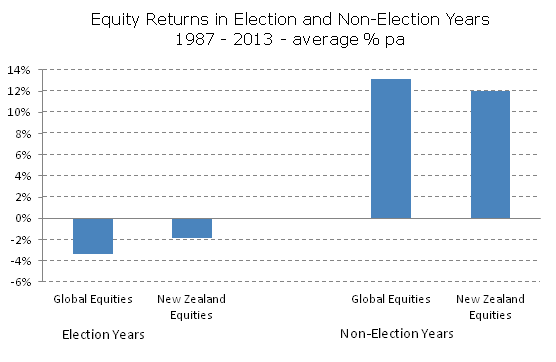
Source: Harbour and Bloomberg
However, 2014 may provide a departure point. This is because the political lines are drawn in a number of areas.
Most obviously a Labour-Green government is likely to develop policy that provides a clear shift to the left. The most distinguishing policies are regulation of the electricity generation sector, the introduction of a capital gains tax and changes to the Reserve Bank policy targets agreement and governance. Whilst these shifts are not dramatic, speeches by both Labour and the Greens imply more radical policy is being considered.
As 2014 unfolds investors may be able to develop a better understanding of the potential policy changes around other infrastructure assets, gaming, broadcasting and potentially the aged care sectors, should there be a change of government.
If a National-led government is to be elected for a third term, it will likely to have to look further to other political parties to continue to govern. The polls currently point to NZ First as potentially a necessary coalition partner. Under a Key government further significant policy change would be unlikely, but a continuation of centre-right policy could be expected.
As it stands today, the first poll of the year - the 3 News Reid Research poll - shows that the centre-right bloc would have 61 seats, the Left bloc would have 56 seats and NZ First with 7 seats would decide government.
iPredict has the odds favouring the National Party for another term in office with a 59.9% chance as at 4th of February, with the odds having risen steadily during January. This suggests that those using this site expect Key to a deal with Peters.
Figure 2: Will there be a National Prime Minister after the 2014 eeneral election?
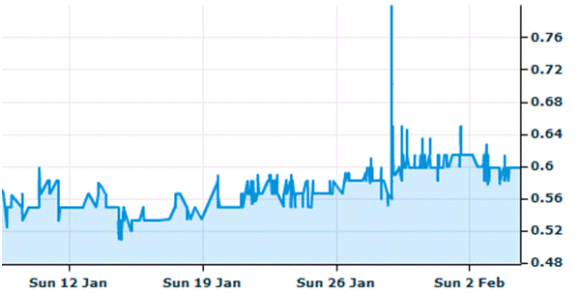
Source: iPredict 4 February 2014
For investors, if the election polls continue to point to a tight race we could observe a weakening in the current high level of business confidence. This is a key lead indicator to watch. In prior pre-election periods the NZ dollar and equity market have built in some risk premium. First NZ Capital have estimated a pre-election fall of up to 5% for the equity market could occur with a recovery should Key lead a third term National government.
From a sector perspective globally facing stocks, those with little regulatory risk are likely to prove better placed if the race remains tight. The sector with the largest risk premium already imbedded is the power utilities sector. The re-election of a Key government would likely see some recovery in the market. We think that it is too early to take a significant “political” stance in portfolios and prefer to focus the portfolio in clear growth and cyclical opportunities.
Is global economic growth going to disappoint?
A key question for markets at the moment is the path of economic data. While a number of high profile data points have been weak, more broad-based surprise indices are relatively flat. The weather in the US has also distorted some data outcomes, and in contrast Japanese and European business confidence indicators are heading higher.
Figure 3: Global Economic Surprise still positive
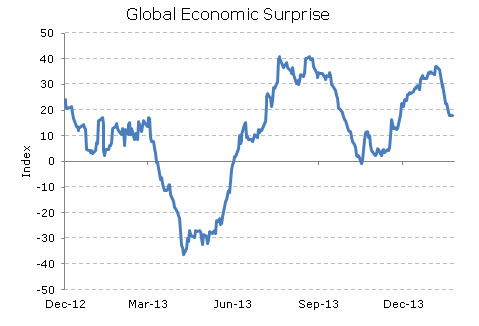
Source: Bloomberg, Citibank
The current US corporate earnings season is showing a positive earnings surprise, consistent with the economic data. In the US, 345 of the largest 500 companies have reported earnings, and companies have beaten on both sales and earnings. Total earnings are 9.7% ahead of last year, with earnings about 5% ahead of expectations for the most recent quarter.
Perhaps the January pull back in global equity markets has been more about how positive sentiment has been for equity markets. Institutions have been positive on equities for some time and some form of correction was probably needed. But this correction has also coincided with global institutional investors building cash positions to over 11% according to Citibank, a level unseen since early 2010. They suggest “there is plenty of buying power seen on market pull backs” .
Our view is that emerging market jitters are not the key theme for 2014. To-date Argentina, Turkey and the Ukraine have provided a headache for investors, but from a fundamental perspective it is difficult to liken these concerns to a full blown crisis. This perception would change if China became an issue. Much will depend on forthcoming data to be released in March. Our reading is that a 7-7.5% growth rate for China is still on the cards for 2014. That being the case, we expect that Chinese steel production will grow at around 5% this year, suggesting additional demand of around 60-65 million tonnes pa.
Many commentators are expecting iron ore prices to fall with the weight of new production. Our take is that stronger global growth may be a more important factor with demand for steel picking up. Recent economic data, weighted for steel producers, shows a good lead for iron ore prices in the near term.
Figure 4: Economic surprise index of major steel producers and iron ore prices
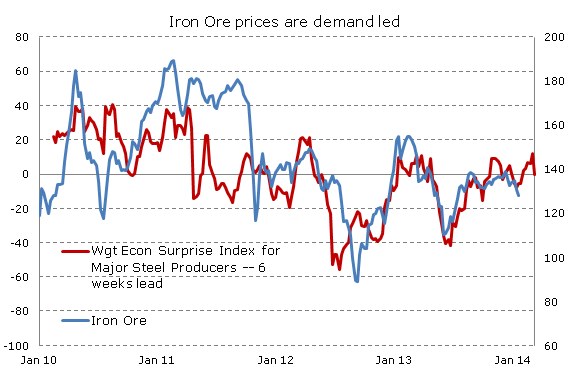
Source: Bloomberg
If that eventuates, we think that China can absorb about 1/2 to 2/3rds of the additional iron ore output from Australia in 2014 and 2015. As a result we expect Australian net export growth will likely remain strong, positively surprising the market.
What can we expect in Australia in 2014?
Economic data remains patchy in Australia; however corporate earnings results are improving with early reporting companies beating expectations on both sales and profits. Moreover, we think some of the leading indicators of activity in Australia are improving, with newspaper and internet job ads, monthly business employment and consumer surveys all suggesting stronger employment growth.
Although many Australian stocks have anticipated an improving domestic economy, the market in general has remained an underperformer. In part this is because the resource sector has lagged the market, but also secular change in the retail and media sectors has seen many stocks perform poorly. However, increasingly analysts are focussing on the improving housing sector, with construction approvals up 20%. Fears about job security appears more an issue for consumption, with hours worked picking up, and a potential for employment to lift, we expect stronger consumption.
Figure 5: Australian employment growth is expected to improve
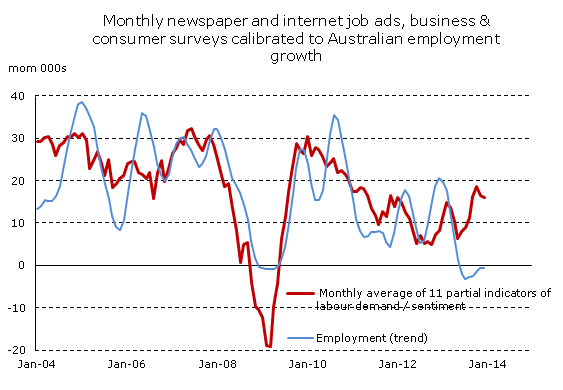
Source: DB, Harbour, Bloomberg
Our conclusion is that increasingly we see better opportunities in the Australian equity market, and that we expect further confirmation of an economic recovery in Australia as 2014 unfolds.
Are tech stocks in a bubble?
It is hard to say. Clearly structural change is occurring. Apps, big data, smart phones, open source software, GPS imbedding, and more are all driving large productivity changes in US and global manufacturing and services sectors. Revenue growth rates are strong and, unlike 2001, many companies are actually making a profit or at least have a line to profitable business models.
New Zealand tech stocks by and large have 3-5 year sales projections that don’t look out of line with global counterparts. While some have potential to be the new standard, and capture large global segments.
Our view is to maintain a portfolio approach to the sector. We have increased our research capacity and are closely monitoring overseas trends through travel and research time spent on the sector. As 2014 unfolds we will be sharing our sector research with clients, discussing the implications of new technology for the financial, retail, and media sectors, and providing further disclosure on how we are considering new potential investments.
Andrew Bascand and Craig Stent
Important disclaimer information
| « Fair play for investors - improving fund disclosure | Buoyant economy, buoyant bond issuance » |
Special Offers
Comments from our readers
No comments yet
Sign In to add your comment
| Printable version | Email to a friend |









